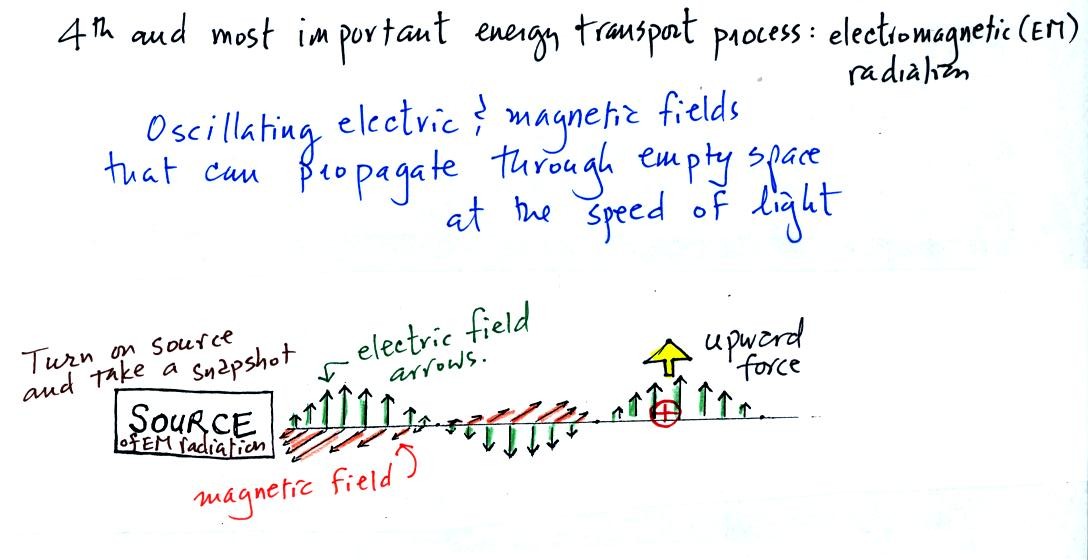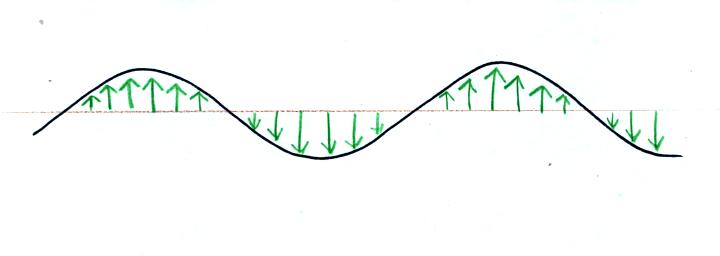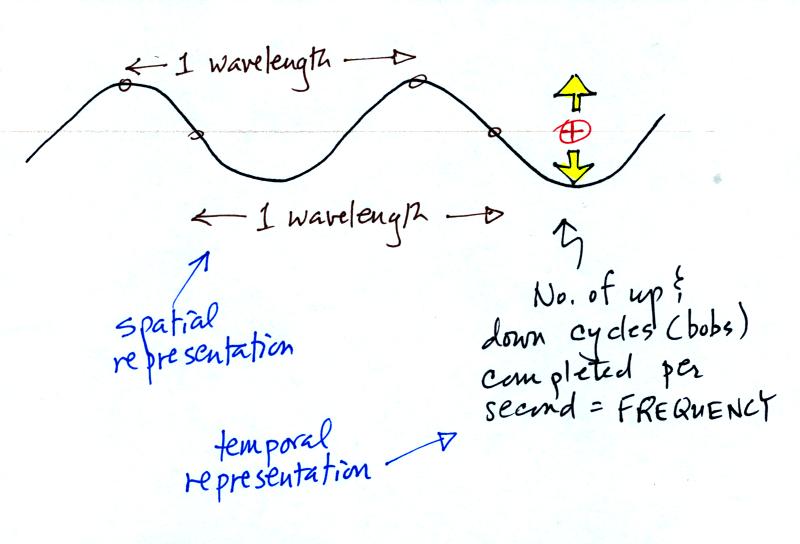Wednesday Feb. 21, 2007
A new optional assignment was handed
out in class. Read The Controls of Temperature in Chapter 3 (pps
63-64) or in the online
notes before starting the assignment. The assignment is due
at the beginning of class next Wednesday (Feb. 28).
The 1S1P Assignment #2 worksheets, that I
forgot to distribute on Monday, were distributed in class today.
Before
reading through today's notes, have a look back at the end of Monday's notes. The last figure shows the
pattern of electric field arrows that would be found around a
positive charge. The electric field arrows show the direction and
strength of the force that would be exerted (by the center charge) on a
second positive charge placed anywhere in the pattern. You'll
also find a couple of sample questions (and answers) about static
electricity and
electric fields.
The figures on p. 60 in the photocopied class notes have been redrawn
below for clarity.

We imagine turning on a source of EM radiation and then a
short time
later we take a snapshot. The EM radiation is a wavy pattern of
electric and magnetic field arrows. We'll ignore the magnetic
field lines. The E field lines sometimes point up, sometimes
down. The pattern of electric field arrows repeats itself.
Note the + charge near the right side of the picture. At the time
this
picture was taken the EM radiation exerts a fairly strong upward force
on the + charge.

Textbooks often represent EM radiation with a wavy line like shown
above. But what does that represent?

The wavy line just connects the tips of a bunch of electric field
arrows.

This picture was taken a short time after the first snapshot when
the radiation
had
traveled a little further to the right. The EM radiation now
exerts a somewhat weaker downward force on the + charge.

The + charge is now being pushed upward again. A movie
of
the +
charge would show it bobbing up and down much like a swimmer in the
ocean would do as waves passed by.

The wavy pattern used to
depict EM radiation can be described spatially in terms of its
wavelength,
the distance between identical points on the pattern.

Or you can
describe the radiation temporally
using the frequency of oscillation
(number of up and down cycles completed by an oscillating charge per
second)

One of the ways of producing EM radiation is to move a charge up and
down. If you move a charge up and down slowly (upper left in the
figure above) you would produce long wavelength radiation that would
propagate out to the right at the speed of light. If you move the
charge up and down more rapidly you produce short wavelength radiation
that propagates at the same speed.
Once the EM radiation encounters the charges at the right side of the
figure above the EM radiation causes those charges to oscillate up and
down. In the case of the long wavelength radiation the charge at
right oscillates slowly. This is low frequency and low energy
motion. The short wavelength causes the charge at right to
oscillate more rapidly - high frequency and high energy.
The characteristics long wavelength - low frequency - low energy go
together. So do short wavelength - high frequency - high energy.
Note that the two different types of radiation both propagate at the
same speed.

This is really just a partial list of some of the different
types of EM
radiation. In the top list, shortwave length and high energy
forms of EM radiation are on the left (gamma rays and X-rays for
example). Microwaves and radiowaves are longer wavelength, lower
energy forms of EM radiation.
We will mostly be concerned with just ultraviolet light (UV), visible
light (VIS), and infrared light (IR). Note the micrometer
(millionths of a meter) units used for wavelength. The visible
portion of the spectrum falls between 0.4 and 0.7 micrometers (UV and
IR light are both invisible). All of the vivid colors shown above
are just EM radiation with slightly different wavelengths. WHen
you see all of these colors together, you see white light.

1.
Unless an object is very cold (0
K) it will emit EM
radiation. All the people, the furniture, the walls and the floor
in the classroom are emitting EM radiation. Often this radiation
will be invisible so that we can't see it and weak enough that we can't
feel it. Both the amount and kind (wavelength) of the emitted
radiation depend on the object's temperature.
2.
The second rule allows you to
determine the amount of EM radiation (radiant energy) an object will
emit. Don't worry about the units,
you can think of this as amount, or rate, or intensity.
Don't worry about σ either, it is just a
constant. The amount depends on temperature to
the fourth
power. If the temperature of an object doubles the amount of
energy emitted will increase by a factor of 2 to the 4th power
(that's 2 x 2 x 2 x 2 = 16). A hot object just doesn't emit a
little more energy than a
cold object it emits a lot more energy than a cold object.
3.
The third rule tells you something
about the kind of radiation emitted
by an object. We will see that objects usually emit radiation at
many different wavelengths. There is one wavelength however at
which the object emits more energy than at any other wavelength.
This is called lambda max (lambda is the greek character used to
represent wavelength). The third rule allows
you to calculate "lambda max."
We'll try to get a better feeling for what these rules mean in
class on Friday.









